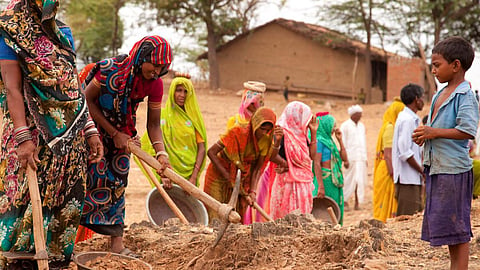
- Topics
- Feature
- Opportunities & Events
- Data
- Hindi Portal
- Topics
- Feature
- Opportunities & Events
- Data
- Hindi Portal

As the Covid-19 pandemic fades from media headlines and public consciousness, it is important to ensure that lessons learned are not forgotten. India’s social protection systems were put to a gruelling test during the two years of the pandemic. We gained valuable insights into what worked and what did not. Two programmes stand out in the role they played protecting vulnerable households from the worst of the pandemic’s effects - National Food Security Act (NFSA) and the Mahatma Gandhi Rural Employment Guarantee Act (MGNREGA).
About 39 percent of all job card-holding households interested in working under the Mahatma Gandhi National Rural Employment Guarantee Act 2005 did not get a single day of work in the Covid year of 2020-21. Also, on average, only 36 percent of households that worked received their wages in 15 days, showed a survey of 2000 households across eight blocks in four states conducted by Azim Premji University in partnership with the National Consortium of Civil Society Organisations on NREGA and Collaborative Research and Dissemination (CORD).
The survey was conducted in November-December 2021 in the following blocks: Phulparas (Madhubani) and Chhatapur (Supaul) in Bihar, Bidar (Bidar) and Devadurga (Raichur) in Karnataka, Khalwa (Khandwa) and Ghatigaon (Gwalior) in Madhya Pradesh, and Wardha (Wardha) and Surgana (Nashik) in Maharashtra. The sampling method of the study ensures that findings are representative of all job-card holding households in the block.
A key motivation of the study was to determine the extent to which working in the programme provided income support or security to vulnerable households during the pandemic. Another important objective was to estimate the extent of and reasons for unmet demand, i.e., a discrepancy between the number of days a household desires to have MGNREGA work and the number of days it actually gets work. Finally, we also investigated other aspects of MGNREGA such as programme awareness, its utility, registration of work demand, modes of work availability, and payment of wages.
Despite these shortcomings, the study found that MGNREGA made a marked difference during the pandemic, protecting the most vulnerable households from significant loss of income. Increased earnings from MGNREGA were able to compensate for somewhere between 20 to 80 percent of income loss depending on the block.
“Our study shows how much the workers value the need and utility of MGNREGA. More than 8 out of 10 households recommended that MGNREGA should provide 100 days of employment per person per year. We also find a massive extent of underfunding. A conservative estimate yields that the allocations in the surveyed blocks should have been three times the amount that was actually allocated in the year after lockdown to fulfill the true extent of work demand, “ noted Rajendran Narayanan, co-author of the study and faculty member at Azim Premji University.
Ashwini Kulkarni of the NREGA Consortium said that “One of the objectives of MGNREGA is as a social protection measure during distress times. During the Covid pandemic and lockdown created unprecedented distress, MGNREGA, as expected, rose to the need and provided work for many more villages and many more households than in the preceding years. MGNREGA’s role for reducing vulnerability has been reemphasized and continues to be of vital importance in post-pandemic times. We as Civil Society Organizations have the responsibility to convey voices of the people to the policy makers to fine tune the implementation process. This report is an effort in this regard.” The key findings of this survey were released in New Delhi recently.
A detailed report on the survey is available on the website of the Centre for Sustainable Employment (CSE) at Azim Premji University here
Key findings
Recommendations of the study
Increase the shelf and scope of permissible works and prioritise community works over individual asset creation to absorb more unmet demand.
Ensure that delay compensation for wage payment delays is paid for the full extent of delay, i.e., till wages are credited to the workers’ accounts to be in compliance with the Act and Supreme Court orders.
Ensure that the GPs get funds in advance and have more authority in sanctioning works. This will ensure that the mandate of the 73rd constitutional amendment is honoured and work is available on demand.